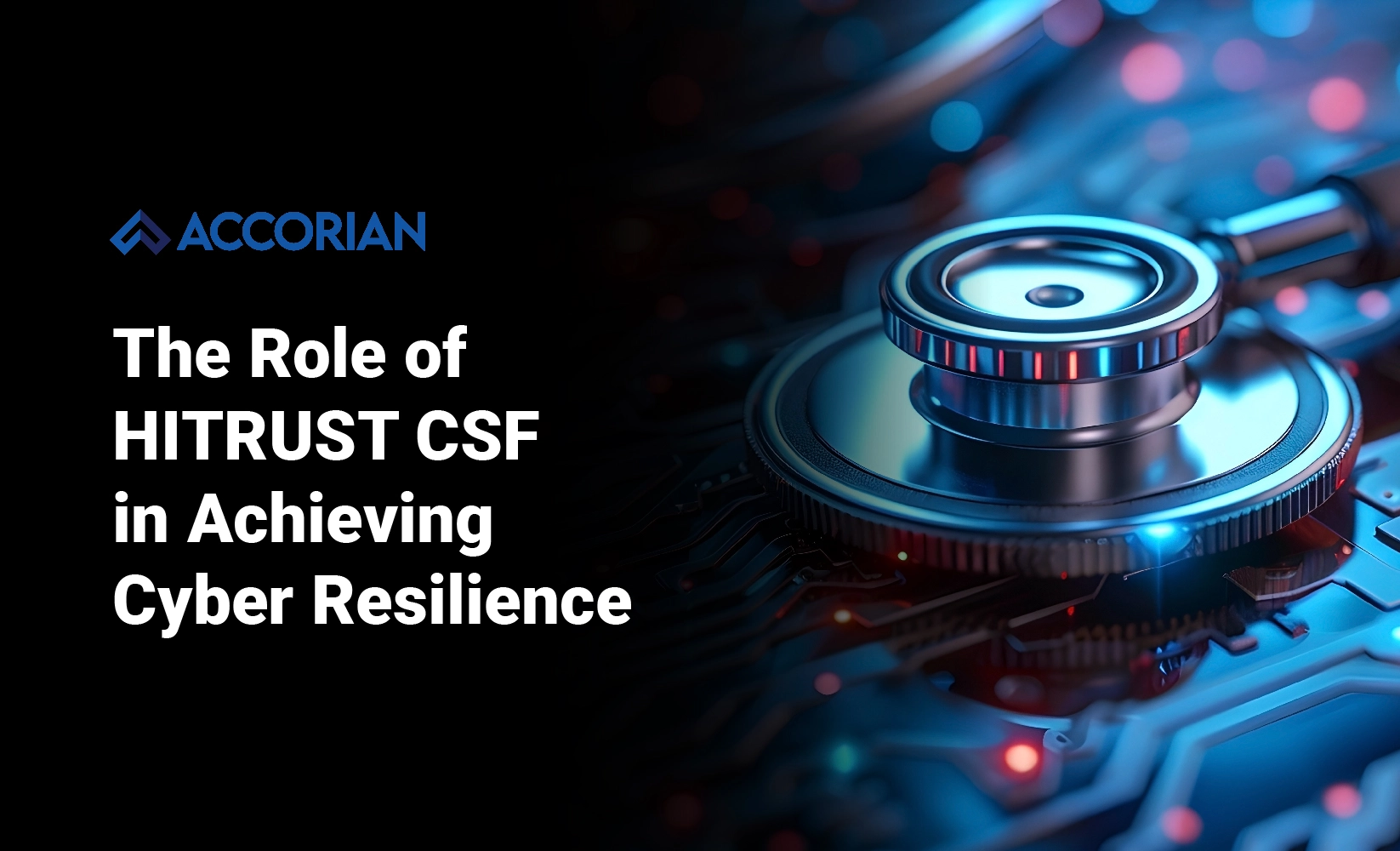Today, healthcare organizations’ essential function depends heavily on connected systems to provide essential services. However, this technological progress presents some serious threats, especially in the cyber sector. Imagine the consequences of a cyberattack compromising patient data due to malware. Hospital operations could be severely disrupted, not by a medical emergency but by a security breach.
This article references HITRUST’s “TRUST REPORT: Navigating the Landscape of Trust in Information Assurance.” It talks about how the HITRUST framework allows organizations to strengthen their protection against security threats. HITRUST recognizes the necessity of being prepared in today’s digital landscape.
How Does HITRUST CSF Strengthen Cyber Resilience?
To fully understand this, it’s essential to grasp the concept of cyber resilience. This refers to an organization’s ability to maintain operations and minimize disruptions even during cyber-attacks. The HITRUST framework is a pivotal tool that aids organizations in achieving and demonstrating this resilience, helping provide a structured approach to planning and maintaining security for operational continuity. By adopting the HITRUST framework, organizations can effectively detect, protect against, respond to, and recover from cyber incidents.
Achieving HITRUST certification signifies that an organization has met rigorous cybersecurity standards, showcasing its capacity to sustain operations despite cyber threats. This certification is a clear indicator of one of the higher levels of cybersecurity resilience.
Types of HITRUST Certifications
HITRUST offers three main certifications:
HITRUST e1 (Essential): This is a certification for small to medium-sized organizations that provides a foundational level of cybersecurity and data protection aligned with core standards and regulations. It contains core security practices and controls and is valid for one year.
HITRUST i1 (Implementable): This certification evaluates and verifies the implementation of comprehensive cybersecurity practices and controls aligned with recognized standards and regulations. It is ideal for smaller organizations or those early in their cybersecurity journey and is valid for one year.
HITRUST r2 (Risk-based): This is a comprehensive, risk-based certification for organizations requiring higher assurance and compliance with multiple regulatory frameworks. Valid for two years with an interim assessment for organizations of various sizes.
These certifications cater to different levels of cybersecurity maturity and assurance needs.
HITRUST Certification and Continuity
Once certified, HITRUST certification is valid for a specified period, contingent upon the certification type and adherence to certain conditions. Specifically, the r2 certification remains valid for two years, while the i1 or e1 certifications are valid for one year. To maintain the certification, organizations must meet the following criteria:
- No Data Security Breaches: There must be no reported data security breaches to federal or state agencies within or impacting the assessed environment.
- Annual Progress on CAPs: Organizations are required to demonstrate annual progress on areas identified in the Corrective Action Plan(s) (CAPs)
- Consistency in Policies and Practices: There should be no significant changes in business or security policies, practices, controls, and processes that could compromise the organization’s ability to meet certification criteria.
Meeting these conditions ensures the ongoing validity of the HITRUST certification and demonstrates the organization’s continued commitment to cybersecurity resilience.
HITRUST CSF Responding to Security Breaches
While no organization is entirely immune to cyber threats, HITRUST-certified entities are better prepared to manage incidents. Only 0.64% of firms with HITRUST certificates reported a security breach within their certified environment between 2022 and 2023, according to the TRUST Report (2024). This figure demonstrates how well the HITRUST framework maintains cyber resilience and constantly improves the level of cyber resilience. HITRUST mandates that they make annual progress on their CAPs.
When a security breach occurs, HITRUST collaborates closely with the impacted organization to evaluate the consequences and make necessary improvements to the HITRUST framework based on insights from the event. This continuous process of development strengthens overall defenses against new cyber threats.
Annual Progress on Corrective Action Plans (CAPs)
When an organization’s HITRUST scores fall below a specified threshold during assessments, they are required to develop a CAP to address security deficiencies. This requirement underscores that organizations with HITRUST certification consistently improve their security more effectively than those without it.
Annual progress on CAPs is crucial for sustaining and enhancing cyber resilience capabilities. HITRUST mandates that organizations demonstrate annual progress on their CAPs. In 2023, HITRUST reported that 28% of assessments did not require a CAP. For assessments necessitating CAPs (r2 assessments), 92% were resolved by the interim evaluation, typically conducted one year after certification (r2 assessments have a 2-year validity). This process ensures that organizations maintain their cyber resilience and continuously strengthen their security posture.
HITRUST Managing Changes Effectively
By recognizing the dynamic nature of organizational environments, HITRUST actively supports certified entities through periods of significant change. This proactive approach allows organizations to adapt while maintaining compliance with HITRUST standards, ensuring continuous validity of their certification. Recent data underscores HITRUST’s steadfast commitment to enhancing cybersecurity. In 2023, most assessments successfully closed CAPs by their interim assessment, further reflecting a sustained commitment to cybersecurity enhancement. Moreover, only a small percentage of certified organizations reported significant changes, thereby demonstrating HITRUST’s role in facilitating agile responses to evolving security challenges.
Recap
The HITRUST framework strengthens the cyber resilience of organizations by following a strict and continual learning approach. By being HITRUST certified, firms acknowledge their capacity to secure their systems and remain compliant with emerging risks. This is how HITRUST CSF has been leading the way to help firms prepare themselves to protect their operations and data against increasing cybersecurity challenges.
It is through HITRUST CSF that enterprises can reinforce their cyber resilience; it serves as proof for proactive cyber security measures undertaken at an age of increased interconnectivity. This drives them towards enhancing their cyber security capabilities on a regular basis while being alive to the threats coming their way time and again from diverse quarters.
FAQs on The Role of HITRUST CSF in Achieving Cyber Resilience
HITRUST CSF offers a framework that helps organizations quickly detect, respond to, and recover from cyber threats like data breaches, keeping operations running smoothly.
The organization’s ability to attain a HITRUST certification indicates it has strong cybersecurity requirements and can continue its business even in the case of cyber-attacks.
To maintain HITRUST certification, organizations must continuously uphold and demonstrate adherence to their security policies and controls. This includes ensuring that no data breaches occur, conducting regular risk assessments, and annually updating and renewing Corrective Action Plans (CAPs) to address any identified gaps or deficiencies. Consistent monitoring and proactive management of these elements are essential to maintaining compliance with HITRUST standards.
The HITRUST Common Security Framework (CSF) helps organizations prevent and manage security breaches by providing a comprehensive, risk-based approach to information security. The CSF integrates various regulatory requirements, industry standards, and best practices into a unified framework that organizations can use to assess and enhance their security posture.
HITRUST’s support is essential during organizational changes because such transitions often introduce new risks, challenges, and potential vulnerabilities to an organization’s security posture.



